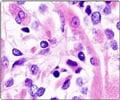Researchers at Children’s Hospital, Boston, have discovered a novel way of increasing stem cells in blood, that holds promise for patients’ undergoing chemotherapy and bone marrow transplant.
The recent research on zebra fish has raised hope about its ability to help patients bounce back sooner after treatment for cancer or recuperating post bone marrow transplant. The research is available in detail in the current issue of ‘Nature’.The discovery, made possible through high-volume drug screening in zebra fish, marks the first time stem-cell production has been induced by a small-molecule drug, says the study’s senior author, Leonard Zon, MD, of the Children’s Hospital Boston Stem Cell Program and Division of Hematology/Oncology. Other studies, including one from Zon's own lab*, have identified ways of increasing formation of blood stem cells, which give rise to each of the body’s various blood cell types. However, the methods are technically complex and haven’t lent themselves to broad medical use.
The hospital now hopes to conduct a clinical trial of the drug, a long-active derivative of prostaglandin E2 known as dmPGE2. This compound was originally tested more than 20 years ago for patients with gastritis, but was never marketed as a drug.
Currently, patients undergoing bone marrow transplant must wait for marrow from a matched donor to replenish their stem cells and reproduce the full array of blood cell types, including all the cells of the immune system. When there’s no suitable donor for a marrow match, patients can receive umbilical cord blood, which also contains blood stem cells. But the number of stem cells in one cord of blood is often not adequate for older children and adults, leaving them with diminished immune function and high risk for infections.
Zon and colleagues Trista North, PhD, and Wolfram Goessling, MD, PhD, both also of Children’s Stem Cell Program, zeroed in on dmPGE2 by screening more than 2,500 chemicals in zebrafish. Knowing that two genes, runx1 and cmyb, are required for blood stem cells to develop in vertebrate embryos, they looked for compounds that altered the expression (activation) of these genes. North spent six months placing 15,000+ tiny embryos in wells, each containing a different chemical – five embryos to a well, 48 wells to a plate – then checking each embryo 24 hours later to monitor its development and count its blood stem cells.
The screen identified 82 chemicals that markedly increased or decreased gene activity. Of these, 10 turned out to affect the prostaglandin pathway: five increased the formation of blood stem cells, and five decreased it. “We weren’t specifically looking for prostaglandins,” says Zon, a Howard Hughes Medical Institute investigator who is also a member of the Harvard Stem Cell Institute. “This was a surprise finding.”
Advertisement
Prostaglandins are known to be released by the body when inflammation is present – such as after an injury – and may be among the compounds that aid recovery. “So it makes some sense that prostaglandins would have the ability to enhance regrowth of cells,” Zon says.
Advertisement
The researchers also confirmed their observations in mammalian models. When dmPGE2 was added to mouse embryonic stem cells in the lab, production of blood stem cells increased. In mice that underwent bone marrow transplant, treatment with dmPGE2 led to enhanced blood-stem-cell formation, and the stem cells remained present in the marrow more than six months after transplantation, indicating long-term engraftment. “The fact that we confirmed the zebrafish discovery in a mammalian system suggests it may also be applicable in humans,” says Goessling.
The clinical trial, projected to begin in 2008 at Children’s Hospital Boston in conjunction with the Dana-Farber/Harvard Cancer Center, will recruit patients undergoing cord blood transplant for leukemia.
Patients will receive cord blood to replenish their blood systems, some of it treated with dmPGE2 to enhance blood-stem-cell formation. “Having more stem cells should help the blood system to regrow faster and minimize complications, such as infections,” says North.
Source-Eurekalert
SAV/M











